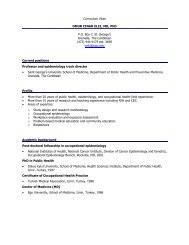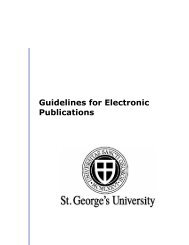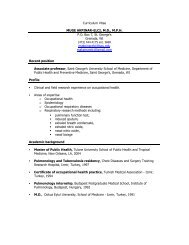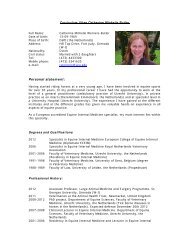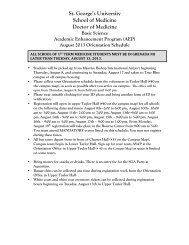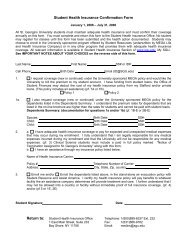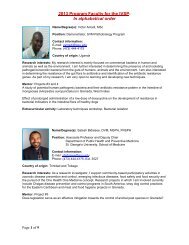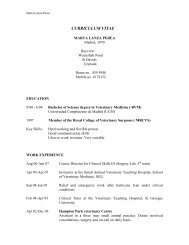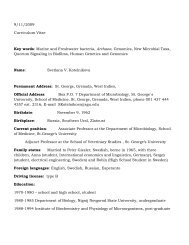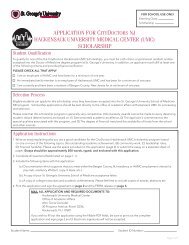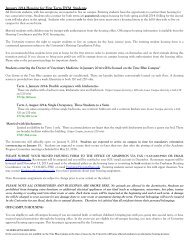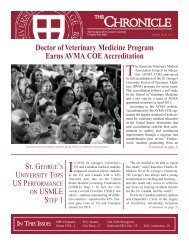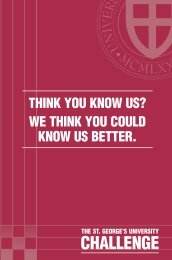SCHOOL OF 2012-2013 - St. George's University
SCHOOL OF 2012-2013 - St. George's University
SCHOOL OF 2012-2013 - St. George's University
Create successful ePaper yourself
Turn your PDF publications into a flip-book with our unique Google optimized e-Paper software.
School of Medicine<br />
Course Descriptions<br />
testing. Both midterm and final examinations are in a<br />
USMLE board format.<br />
• Laboratory Exercises<br />
<strong>St</strong>udy of the cadaver is achieved through prosected<br />
cadaveric specimens and follows a traditional sequence<br />
of the back, upper extremity, thorax, and abdomen prior<br />
to midterm. The sequence continues with the pelvis,<br />
perineum, lower extremity, head, and neck for the final<br />
examination. Instructions for studying the prosections are<br />
given in a prosection manual. Small groups of no more<br />
than four students are rotated through several prosected<br />
specimens with the guidance of faculty.<br />
• Small Group Discussion<br />
The Human Gross and Developmental Anatomy course<br />
is further highlighted by several three-hour small group<br />
discussion sessions. With the guidance of clinical tutors,<br />
small groups of no more than eight students per group<br />
have the opportunity to learn the initial steps of physical<br />
examination, such as inspection, percussion, auscultation,<br />
and so forth, through a problem-based environment. In<br />
addition, relevant core clinical cases are presented to<br />
the students in order to facilitate basic interpretation<br />
of clinical anatomy, congenital defects, contemporary<br />
imaging, professional competencies, team-based<br />
interpersonal skills, and research articles. The course is<br />
specifically designed to enhance clinical integration of<br />
Basic Sciences material. In addition, all students learn<br />
anatomical and clinical fundamentals of ultrasonography<br />
(approximately one-hour, weekly sessions through out the<br />
course) on standardized patients.<br />
Behavioral Sciences<br />
John P. Pettus, PhD, Co-Chair<br />
David L. Brown, MD, PhD, Co-Chair<br />
BEHS 640<br />
Behavioral Sciences and Medicine<br />
The course introduces students to the fundamental<br />
principles of human behavior and development, with<br />
particular emphasis upon the role of behavior within the<br />
context of illness and the medical encounter. Theories<br />
contributing to the understanding of normal human<br />
development and psychopathology are examined.<br />
An overview of several major psychological theories of<br />
human behavior is provided, including psychodynamic,<br />
behavioral, cognitive, and biological models. Exposition<br />
of these systems leads to discussion of a number of<br />
topics, including systems of psychotherapy, behavior<br />
modification, biological/genetic bases of behavior,<br />
psychological assessment, complementary/alternative<br />
treatment approaches, and psychopharmacological<br />
intervention. An evidence-based approach is adopted in<br />
assessing treatment effectiveness, and data supporting the<br />
importance of a biopsychosocial approach to patient care<br />
is presented.<br />
There is an emphasis upon behavioral medicine/<br />
health psychology and the role of cognitive/behavioral<br />
approaches in the modification of risky health behavior.<br />
Special attention is given to the crucial role of cultural<br />
factors within the doctor-patient encounter and health<br />
care setting, as well as to the importance of cultural<br />
competence in the provision of medical care. The role of<br />
the family is noted within this context, and life-disrupting<br />
58 | <strong>St</strong>. George’s <strong>University</strong>



